|
A comprehensive guide to the C&E
Railway 1891 Combination Station & Freight House
Mackenzie and Mann influenced
the design of Central Alberta's first railway stations
Revised April 2022
Photo descriptions
and credits at bottom of page.
The Calgary & Edmonton
Railway Company was an independent company built by
William Mackenzie and Donald Mann as well as CPR contractor James
Ross and Herbert Holt. They were railway builders and never intended to
run trains. The intention was to build a line and lease or sell it to another
operator, presumably the Canadian Pacific Railway, which at the time was
the only viable operator in the territory which is now Alberta.
 Construction
started in Calgary in the summer of 1890 before the site was chosen
for crossing the Red Deer River and reached the Red Deer townsite in the
fall soon after James Ross negotiated an arrangement to cross the
river and establish a community on the substantial land holdings of
Rev. Leonard Gaetz. Construction
started in Calgary in the summer of 1890 before the site was chosen
for crossing the Red Deer River and reached the Red Deer townsite in the
fall soon after James Ross negotiated an arrangement to cross the
river and establish a community on the substantial land holdings of
Rev. Leonard Gaetz.
 The new railway gave the Canadian Pacific Railway the first rights to a
renewable 6-year lease once completed. It was decided to establish a
station building about every 18 miles
along the line and a temporary station at intermediate sidings about midpoint between
built stations.
Initially most sidings were a number but the CPR took on the
responsibility of naming those sidings along the route between Edmonton and Fort MacLeod. The new railway gave the Canadian Pacific Railway the first rights to a
renewable 6-year lease once completed. It was decided to establish a
station building about every 18 miles
along the line and a temporary station at intermediate sidings about midpoint between
built stations.
Initially most sidings were a number but the CPR took on the
responsibility of naming those sidings along the route between Edmonton and Fort MacLeod.
Although the CPR took an active role in the design of structures,
including stations, those along the Calgary and Edmonton Railway and
other railways built by William Mackenzie and Donald Mann had a
distinctive flavour and, with few exceptions, were not built
elsewhere.
The first stations were actually boxcars but those at the primary
sidings (every 18 miles) were quickly
replaced by cookie-cutter "permanent" combination stations with
attached freight house
in 1891 and were constructed in approximately three weeks each.
 These stations were constructed at These stations were constructed at
Airdrie (Siding 2), Carstairs
(Siding 4),
Olds (Siding 6), Innisfail (Poplar Grove/Siding 8), Red
Deer, Lacombe (Barnett's/Siding 12),
Ponoka (Battle River/Siding
14),
Wetaskiwin (Peace Hills/Siding 16),
Leduc (Telford) and
South
Edmonton (Strathcona) as well as
De Winton, Okotoks, High River, Claresholm
and Nanton south of Calgary in 1892.
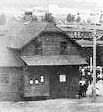 Some
were later replaced with newer and larger stations but some stayed
in service until the end of steam in the 1950s including those at
Ponoka, Innisfail and Olds. Some
were later replaced with newer and larger stations but some stayed
in service until the end of steam in the 1950s including those at
Ponoka, Innisfail and Olds.
Similar stations were built in Saskatchewan and Manitoba
on railway lines built by Mackenzie and Mann as well as a few on
other independent lines operated by Canadian Pacific. A few of these
stations were later built by the CPR at other locations including
Morley and Langdon, Alberta.
Intermediate siding stations along the C & E (Crossfield, Didsbury,
Bowden, Penhold, Blackfalds, Hobbema and Millet) were temporary
portables until more permanent stations were built starting in 1904.
When Mackenzie and Mann formed the
Canadian Northern Railway to compete with the CPR, the CPR
negotiated a long-term lease with the Calgary and Edmonton Railway
and eventually took over the line.

Photos from the 1891-1892
period suggest that the portion of the station that contained the
residence, office and waiting room had a shingled roof while the
freight house portion had a metal sheeting roof.
These cookie-cutter stations were built approximately every 18-20
miles between Calgary and Edmonton and were constructed in about
three weeks each.
Although there are no colour photos of these stations, other
CPR-influenced stations of the period had a cream, beige and
burgundy colour scheme.
 This station was typically 44'x26'
as built with a waiting room and office, plus
a living room and a kitchen (later built as a lean-to on the back side on the main
floor on some stations leaving space for an additional waiting room) and 3 bedrooms upstairs for the station agent's family.
Several variations evolved over time on the interior layout. The freight house
was approx. 17' as built but usually expanded to 30' or more in the
mid-1890s. This station was typically 44'x26'
as built with a waiting room and office, plus
a living room and a kitchen (later built as a lean-to on the back side on the main
floor on some stations leaving space for an additional waiting room) and 3 bedrooms upstairs for the station agent's family.
Several variations evolved over time on the interior layout. The freight house
was approx. 17' as built but usually expanded to 30' or more in the
mid-1890s.
A replica of this station is located in South Edmonton (Strathcona)
based on the Innisfail station although the freight shed portion was
not replicated. An original station of this type acts as a museum in
Strathclair, Manitoba. No station of this type was built after 1906.
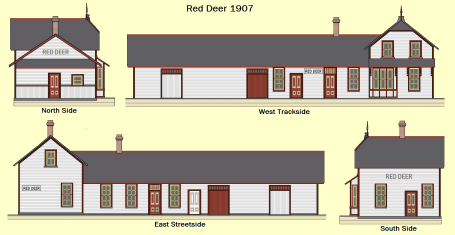
Although these stations
started out virtually identical, it wasn't long before
modifications were made to each station to make them more functional
according to the needs of the community and the station master.
This resulted
in some distinction between stations but the primary characteristics remained.
 In
Red Deer, it would seem that when the freight shed was expanded in
the mid-1890s, the waiting room was relocated to make it larger and
to keep the living quarters on the south side of the station. In
Red Deer, it would seem that when the freight shed was expanded in
the mid-1890s, the waiting room was relocated to make it larger and
to keep the living quarters on the south side of the station.
Most of the combination station and freight house structures were
re-painted in an off-white or light grey colour scheme with cream
and tuscan red trim although variations occurred from station to
station. Eventually the colour scheme changed to a tuscan red with
cream and chocolate trim, again with variations.

Modifications
to some original stations such as the one at Innisfail included the
addition of a lean-to at one end, a kitchen addition on the 'back'
side, relocation of doors, windows and chimneys as well as a dormer
on the upper floor.

After
Red Deer officially became a division point in 1907, a new station
was contemplated. When the new station opened in late 1910, the
combination station was relocated from north of the new station to
south of it, turned 180 degrees and repainted tuscan red with cream
and chocolate trim. It was used exclusively as a freight shed.
 The
Red Deer freight shed
was expanded and used until the early
1960s. It was demolished in 1965. This view is on the street side
(originally the track side). The
Red Deer freight shed
was expanded and used until the early
1960s. It was demolished in 1965. This view is on the street side
(originally the track side).
Due to variations in how the local dealer mixed the paint, CPR
tuscan red as a station colour ranged from a rich deep red (Colonial
red) to maroon to boxcar red to brown. Weathering and age could also
alter the colour. Tuscan red as a locomotive or passenger car colour
was more consistent but slight variations occurred according to
which paint shop did the work.
Wood Combination Station and Freight House
(1891-1892)
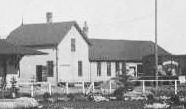 Red Deer Red Deer
 built in
1891 to replace boxcar station; expanded in 1890s; replaced by a new brick
station in 1910 after Red Deer became a division point in 1908;
combination station rotated and moved south of
the new station and converted to
a separate freight house which was expanded twice; demolished 1965 built in
1891 to replace boxcar station; expanded in 1890s; replaced by a new brick
station in 1910 after Red Deer became a division point in 1908;
combination station rotated and moved south of
the new station and converted to
a separate freight house which was expanded twice; demolished 1965
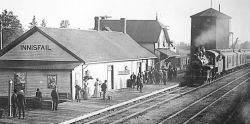
Innisfail
built 1891; expanded and modified in 1890s; relocated from west side of tracks to east side in
1900s; closed 1961; demolished; replaced by cinder block station
further north

Olds built 1891 to replace boxcar station; addition 1913; closed 1962 and
sold;
mostly demolished but portion moved to nearby farm; replaced by cinder block station

Lacombe built 1891 to replace boxcar station; addition 1910;
partially destroyed by explosion October 1911 (1 person killed); new station built 1911 prior to explosion
and opened three weeks later due to importance as the terminal of
the Stettler subdivision; combination station relocated and used as freight house

Ponoka
built 1891; expanded and modified; used until 1960s; demolished 1968
Wetaskiwin built 1891;
expanded in 1890s; replaced by new station
in 1908 due to importance as the connecting point with Camrose
subdivision which was part of the 2nd main line between Edmonton and
Winnipeg; combination station relocated and used as freight shed;
later demolished
Carstairs built 1891; demolished 1978
A total of 18 stations of this type were built in Alberta (most on
the Calgary and Edmonton Railway between Edmonton and Fort McLeod,
later absorbed by CPR, and at Langdon and Morley), another
18 in Saskatchewan (built on the Qu'Appelle, Long Lake &
Saskatchewan Railway, later absorbed by CNR), and 15 in Manitoba
along the Manitoba and Northwestern Railway.
Combination Stations Replaced
 Several
of the larger communities or ones that were junctions had their
stations replaced before the First World War. Wetaskiwin's was
replaced in 1907-08 by a special woodframe station. Red Deer's was
replaced by in 1910 by a special brick chateau-style station.
Lacombe's was replaced in 1911 by a special woodframe station.
Leduc's was replaced in 1914 by a CPR standard A2 Western station. Several
of the larger communities or ones that were junctions had their
stations replaced before the First World War. Wetaskiwin's was
replaced in 1907-08 by a special woodframe station. Red Deer's was
replaced by in 1910 by a special brick chateau-style station.
Lacombe's was replaced in 1911 by a special woodframe station.
Leduc's was replaced in 1914 by a CPR standard A2 Western station.
In the 1960s, the combination stations at Innisfail and Olds were
replaced by an uninspiring cinder block building.
Photo descriptions and credits:
Header: Red Deer CPR 1910 station, park and C&ER 1891 combination
station as freight house 1911
(Red Deer Archives P3202);
Red Deer 1891 C&ER combination station 1892 (source unknown);
Red Deer 1891 C&ER combination station 1898 (Red Deer Archives
P3206);
Red Deer 1891 C&ER combination station 1908 (Red Deer Archives);
Red Deer C&ER combination station relocated as freight house
1912 (Red Deer Archives 3202 cropped);
Rendering of Red Deer combination station in 1891 (Paul Pettypiece);
Interior plan of C&ER combination station 1891 (Paul Pettypiece);
Rendering of Red Deer combination station in 1908 (Paul Pettypiece);
Interior plan of C&ER combination station in 1908 (Paul Pettypiece);
Rendering of Innisfail combination station in 1911 (Paul Pettypiece);
Rendering of Red Deer combination station converted to freight house
in 1911 (Paul Pettypiece);
Rendering of Red Deer CPR freight house 1955 (Paul Pettypiece);
Red Deer C&ER combination station street view 1910 (Red Deer
Archives);
Red Deer C&ER combination station 1905 (Red Deer Archives
P3201);
Innisfail Calgary & Edmonton Railway 1891 station 1890s (Glenbow
Archives NA-1709-71);
Olds C&ER 1891 combination station 1897 (Olds Historical Society);
Lacombe C&ER 1891 combination station 1910 (Lacombe & District
Historical Society);
Ponoka C&ER 1891 combination station c1910 (Fort Ostell Museum
Ponoka);
Rendering of replacement Red Deer CPR station 1910 (Paul Pettypiece)
Note: All renderings are the
intellectual property of Paul Pettypiece and may only be used for
personal or historical use.
Photos courtesy of Red Deer Archives, Glenbow Archives, Olds
Historical Society, Lacombe & District Historical Society, Fort
Ostell Museum Ponoka and
Paul Pettypiece. One has an unknown source.
|
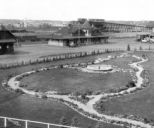
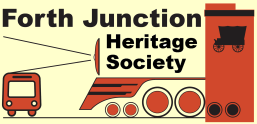
 Construction
started in Calgary in the summer of 1890 before the site was chosen
for crossing the Red Deer River and reached the Red Deer townsite in the
fall soon after James Ross negotiated an arrangement to cross the
river and establish a community on the substantial land holdings of
Rev. Leonard Gaetz.
Construction
started in Calgary in the summer of 1890 before the site was chosen
for crossing the Red Deer River and reached the Red Deer townsite in the
fall soon after James Ross negotiated an arrangement to cross the
river and establish a community on the substantial land holdings of
Rev. Leonard Gaetz.  The new railway gave the Canadian Pacific Railway the first rights to a
renewable 6-year lease once completed. It was decided to establish a
station building about every 18 miles
along the line and a temporary station at intermediate sidings about midpoint between
built stations.
Initially most sidings were a number but the CPR took on the
responsibility of naming those sidings along the route between Edmonton and Fort MacLeod.
The new railway gave the Canadian Pacific Railway the first rights to a
renewable 6-year lease once completed. It was decided to establish a
station building about every 18 miles
along the line and a temporary station at intermediate sidings about midpoint between
built stations.
Initially most sidings were a number but the CPR took on the
responsibility of naming those sidings along the route between Edmonton and Fort MacLeod.
 These stations were constructed at
These stations were constructed at
 Some
were later replaced with newer and larger stations but some stayed
in service until the end of steam in the 1950s including those at
Ponoka, Innisfail and Olds.
Some
were later replaced with newer and larger stations but some stayed
in service until the end of steam in the 1950s including those at
Ponoka, Innisfail and Olds.
 This station was typically 44'x26'
as built with a waiting room and office, plus
a living room and a kitchen (later built as a lean-to on the back side on the main
floor on some stations leaving space for an additional waiting room) and 3 bedrooms upstairs for the station agent's family.
Several variations evolved over time on the interior layout. The freight house
was approx. 17' as built but usually expanded to 30' or more in the
mid-1890s.
This station was typically 44'x26'
as built with a waiting room and office, plus
a living room and a kitchen (later built as a lean-to on the back side on the main
floor on some stations leaving space for an additional waiting room) and 3 bedrooms upstairs for the station agent's family.
Several variations evolved over time on the interior layout. The freight house
was approx. 17' as built but usually expanded to 30' or more in the
mid-1890s. 
 In
Red Deer, it would seem that when the freight shed was expanded in
the mid-1890s, the waiting room was relocated to make it larger and
to keep the living quarters on the south side of the station.
In
Red Deer, it would seem that when the freight shed was expanded in
the mid-1890s, the waiting room was relocated to make it larger and
to keep the living quarters on the south side of the station. 

 The
Red Deer freight shed
was expanded and used until the early
1960s. It was demolished in 1965. This view is on the street side
(originally the track side).
The
Red Deer freight shed
was expanded and used until the early
1960s. It was demolished in 1965. This view is on the street side
(originally the track side). Red Deer
Red Deer  built in
1891 to replace boxcar station; expanded in 1890s; replaced by a new brick
station in 1910 after Red Deer became a division point in 1908;
combination station rotated and moved south of
the new station and converted to
a separate freight house which was expanded twice; demolished 1965
built in
1891 to replace boxcar station; expanded in 1890s; replaced by a new brick
station in 1910 after Red Deer became a division point in 1908;
combination station rotated and moved south of
the new station and converted to
a separate freight house which was expanded twice; demolished 1965



 Several
of the larger communities or ones that were junctions had their
stations replaced before the First World War. Wetaskiwin's was
replaced in 1907-08 by a special woodframe station. Red Deer's was
replaced by in 1910 by a special brick chateau-style station.
Lacombe's was replaced in 1911 by a special woodframe station.
Leduc's was replaced in 1914 by a CPR standard A2 Western station.
Several
of the larger communities or ones that were junctions had their
stations replaced before the First World War. Wetaskiwin's was
replaced in 1907-08 by a special woodframe station. Red Deer's was
replaced by in 1910 by a special brick chateau-style station.
Lacombe's was replaced in 1911 by a special woodframe station.
Leduc's was replaced in 1914 by a CPR standard A2 Western station.